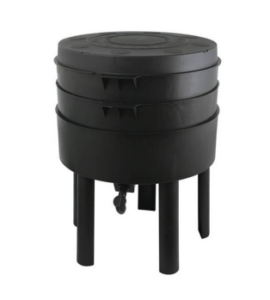Vermicomposting is the process by which earthworms or Black Soldier Fly grubs, along with microorganisms, and other decomposers convert organic materials to a soil conditioner called vermicompost. Vermicompost has many benefits for soils, including improvement of soil structure, reducing erosion, increasing soil porosity and moisture-holding capacity, and improving pH of acidic soil. Numerous studies have shown that vermicompost also increases the growth and health of plants, and suppresses plant diseases and pests.
Although Black Soldier Fly grubs and several species of earthworms may be used in vermicomposting, most people use Eisenia fetida (common name: red wiggler). Red Wigglers thrive in warm, moist conditions. They will consume animal manures, food waste, agricultural crop residues, yard trimmings, scrap paper, and other organic byproducts. Vermicomposting can take place anywhere and at any scale – in classrooms, homes, farms, warehouses, etc.
There’s no better way of composting indoors than vermicomposting – letting the worms do the work. With a little care your worm bin can be odor and gnat free. There are many styles of bins that can be bought or made yourself, your choice depends on how much material you have to compost on a weekly basis and how much space you have to dedicate to composting. Here are a few styles to choose from.
The cheapest and simplest worm bin is this home-made model. All you need to make it is a plastic tub, a tray to set it in and a drill. Put small holes in the walls for air and in the bottom for drainage then add moist shredded paper, food scraps and worms. It can fit under a desk or sink, or be tucked into a closet or on a heated porch.
Stackable bins are for higher volume composting. Moist paper and food scraps are put into the top bin so when all the food has been eaten from the lower bins the worms move up. The lower bin’s compost can then be harvested and the empty bin stacked on top. Most stackable bins feature a spigot at the bottom so compost tea can be collected easily. San Diego County’s Compost Voucher program gives residents the ability to buy one of these free standing, stackable worm bins at a discount.
Hanging worm bins can hang in a frame, from a shelf in a closet or from rafters in an attic, basement or shed. The worms continuously move up to the top of the bag where the food is, allowing you to harvest the compost from the opening at the bottom. The “compost tea” dripping from below the bag can be collected in a small container.
Black Soldier Fly (BSF) grubs are voracious eaters and can compost meat and bones as well as any type of food and yard waste. Besides the compost that they leave behind, the worms themselves are a valuable food for chickens, hogs, songbirds and fish. BSF composting is a little more complicated than using Red Wigglers, so we’ve dedicated a whole page to it. Click here to learn about BSF composting.
The Worm Barn at NC State University’s Compost Learning Lab has several styles of home worm bins so you can check them out before you buy. For a tour contact Rhonda Sherman.
The EPA has a great website on How to Create and Maintain an Indoor Worm Composting Bin!
To learn more about vermicomposting, check out these links:
NC State University’s Vermicomposting Website
NC State University’s Annual Vermiculture Conference
Vermicomposting classes, resources on how to start a worm bin or a vermicomposting business, curriculum for 5th graders, and where to buy worms.
California Integrated Waste Management Board
Vermicomposting, classroom activities and an interactive game.
Canada’s Office of Urban Agriculture
Vermicomposting and related resources.
![]()












Leave a Reply
Want to join the discussion?Feel free to contribute!